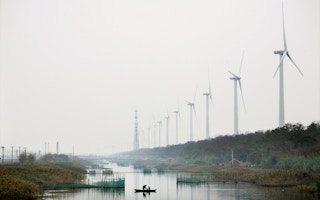While China added another 24.3GW of solar in the first half of 2018, equal to total solar installations in India to date where a new transformation is underway, the story of China’s overseas renewables investment, reaching beyond the formal Belt and Road Initiative, remains largely untold.
China’s investment in foreign wind-powered electricity markets has surpassed $12 billion in Europe and Australia alone as private and stated-owned Chinese companies move aggressively to capitalise on fast-growing renewable energy markets, as shown in our new research brief published today. Most of the wind investment activity has been in Europe, which follows recent trends.
Chinese state-owned independent power producers have acquired big wind projects in nine European countries, aiming especially to diversify their foreign portfolios and gain expertise in offshore wind technology.
The UK is Europe’s largest offshore wind market, which is set to double by 2030, providing up to a third of the country’s electricity. Some of the top Chinese state-owned power companies, like State Development and Investment Corp (SDIC) and China Resource Power, are buying interests in wind projects off the eastern coasts of England and Scotland, reflecting a wider trend toward Chinese investment in the UK energy sector.
China is now a driver of the European energy transformation, and its international leadership in low emissions sectors of the future is entirely aligned with efforts to increase China’s global economic influence.
While Chinese foreign renewable energy investments were boosted by the launch five years ago of its Belt and Road Initiative (BRI), its foreign renewable energy investment now extends well beyond that framework.
IEEFA has already shown that China’s 2017 investment in new energy technology and resources reached $44 billion, up from $32 billion in 2016, with investment reaching beyond official BRI nations to include Europe and South America. This is a superpower taking its energy policy global.
Coal for developing nations
There is a flipside. China’s main misstep in its globalisation of energy policy is continuing coal investment overseas despite its own long-term coal decline, which started in 2013, and its embrace of renewables. While China is establishing itself as a renewables leader in richer nations, it is still pushing its polluting coal technology in developing nations of Asia and Africa.
It’s clear that renewables will be the dominant energy technology of the following decades. Whether this happens fast enough to avoid the worst impacts of climate change is a separate question, but one which also has reliability of investment implications for the coal industry given that its out-dated technology drives emissions up more than any other sector, making it an increasingly risky bet.
The quicker China embraces the direction energy markets are moving in, the more it can ensure it is the global technology leader others follow.
From 2003 to 2017, China’s power investments in Southeast Asia included $12 billion in coal projects, despite the abundance of solar and wind power investment potential in those markets. Wind and solar investment has ramped up within the last few years as costs have declined dramatically, but it is clear that, in the Belt and Road and other developing countries, Chinese coal power investment is still significant.
China Huadian Corp was the biggest Chinese international coal investor with a total of $11.2 billion of investment in that sector from 2003 to 2017, followed by Shenhua ($4.6 billion) and China Huaneng Group ($3.2 billion).
“
While China is establishing itself as a renewables leader in richer nations, it is still pushing its polluting coal technology in developing nations of Asia and Africa.
Huadian plans to build a 1,320 MW coal-fired power plant in Bangladesh (a signatory to the BRI). PowerChina also has a Bangladesh coal project and is contracted to construct the controversial Lamu project in Kenya, of which Huadian is part of the proponent consortium.
Pakistan, a key BRI country, is hosting substantial Chinese involvement in infrastructure investment, including in coal-fired power. Companies like China Huaneng Group and China Machinery Engineering Corp (CMEC) are heavily involved in Pakistani coal projects. Shanghai Electric and Dongfang Electric are part of a consortium that has recently been awarded a tender to build the 6,000 MW Hamrawein coal power project in Egypt, a nation on the BRI crossroads between Asia, Africa and Europe.
World is watching
As China powers into profitable European wind markets and accesses new deals, other major investors like the $1.1 trillion Norwegian Sovereign Wealth Fund continue to hesitate to enter the growing trillion-dollar unlisted infrastructure market, which is dominated by renewables.
Meanwhile, other investors like the $73 billion Japanese company, SoftBank are—like Chinese private and state actors—shaking up the energy world. In the past 12 months alone SoftBank has announced grand plans to invest $60 billion to $100 billion in Indian solar and $200 billion in Saudi Arabian solar.
Competitiveness for new clean energy technology is only going to increase, especially given that climate risks are now unfolding in real time. The stranding of coal plants is likely to happen even faster than expected. And more steel is going to be in put in the ground for solar and wind plants to take us into a new energy future.
China is setting itself up to be at the forefront of renewable technology—but how fast will they move and who will follow?
Simon Nicholas is an energy finance analyst with the Institute for Energy Economics and Financial Analysis. This story was published with permission from Thomson Reuters Foundation, the charitable arm of Thomson Reuters, that covers humanitarian news, women’s rights, corruption and climate change. Visit news.trust.org.


















